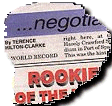

Revisiting November 19
(c)copyright
WITH 22 teams having confirmed their places, there were only two more spots in the 1990 World Cup still available by November 19, 1989. Because of the cancellation of two games involving Guatemala and El Salvador, due to civil unrest in the latter, November 19 represented the last day of the World Cup qualifying competition. A final opportunity for four teams.
While Cameroon and Tunisia battled in the second leg of their African final round tie in Tunis, Trinidad and Tobago entertained the U.S.A. in Port of Spain. Two consecutive wins over Guatemala had put the “Strike Squad” in second place in the CONCACAF final round group on nine points, just two behind Costa Rica - which had wrapped qualification back in July. The Americans, by contrast, were finding goals hard to come by and had been held to 0-0 draws by both Guatemala and El Salvador in their previous two qualifying matches. They were in third place in the group on eight points, one behind Trinidad and Tobago, and two behind Costa Rica. This country only needed a draw to secure the second qualifying spot from the CONCACAF zone, and make it to its first World Cup finals.
More than two months of anticipation preceded the match and, on the day itself, the National (now Hasely Crawford) Stadium started being filled at a tremendous rate, soon after the opening of the gates at 7 a.m. By game time (3:30 p.m.) the 25,000 capacity arena was packed to the seams. The most official - and logical – estimate puts the final attendance at 35,000. However, some journalists, in their accounts, chose to go all the way to 46,000.
Fans had been told to wear something red and everyone dutifully complied: by the time the local players arrived at the stadium, some two hours before kick-off, they were greeted by a crimson tide that could be seen from miles away. They had just made the long journey from their base at Forest Reserve and had apparently been advised to go out and greet the fans. Only afterwards did they return to the dressing rooms to get ready for the match.
In the years that have followed there has been speculation as to whether fatigue, induced by travelling for hours in a cramped bus and some other pre-game distractions were major factors in Trinidad and Tobago’s tepid performance. It could have also been the subconscious knowledge that one required only a draw to get to Italy. During the early part of the game it became obvious that the home side was not extending itself and was allowing the normally defensive Americans to make all the running. It was in the 31st minute that Paul Caligiuri made all the difference. As a 21 year old still at UCLA, he scored the winner on his debut as the U.S. beat Trinidad and Tobago in a World Cup qualifier in Torrance, California on May 19, 1985. Four years later, history would repeat itself as Caligiuri collected a left sided throw in from Tab Ramos, lobbed the ball over Kerry Jamerson and fired a dipping 40-yard shot which surprised Trinidad and Tobago goalkeeper, Michael Maurice as it landed into the far corner of the net.
Just a minute before the goal, Trinidad and Tobago had a penalty-appeal turned down when forward Philbert Jones went down in the U.S. penalty area under a late tackle from American defender John Doyle. Argentinean referee, Juan Carlos Lostau, simply waived play-on as Jones appealed while getting up from the tackle. Many Trinidadians have argued that Jones should have stayed down in order to have convinced the referee of the illegality of Doyle’s challenge. However, during the World Cup finals, in almost exact circumstances highlighted by TTT host Ashford Jackman, the same Juan Carlos Lostau awarded a penalty to the Netherlands when West Germany’s Jurgen Kohler caught Marco Van Basten. Just like Jones, Van Basten, in one motion, rolled up to his knees, holding his arms aloft to make the successful appeal.
It was only in the second half that Trinidad and Tobago showed some aggression. But the U.S. switched to its defensive mode to hold out against the locals. Indeed, the only moment of danger created by Trinidad and Tobago came with just 20 minutes to go when Leonson Lewis raced down the left flank and pulled the ball back. Unfortunately, 20-year old U.S.A. goalkeeper Tony Meola was able to gather the sphere before any opposing player could get to it. The final seconds of the game were surreal. While some Trinidadian players, such as Brian Williams, displayed the desperation mandated at this point, others seemed already resigned to the unwanted result.
The final whistle brought the usual contrast of American celebration amidst local despair. Trinidad and Tobago’s tearful players disappeared into the tunnel, but then returned to the field to salute the fans who had enthusiastically supported them throughout the 19-month-long qualifying campaign. The crowd returned the compliment by cheering on the players. It was a gesture which brought the people of this country a FIFA Fair Play Award: a welcome gesture by football’s world governing body but, as any true sports fan will testify, scant consolation for missing out on football’s greatest event.
TRINIDAD AND TOBAGO: Michael Maurice – Clayton Morris, Dexter Francis, Brian Williams, Marvin Faustin, Kerry Jamerson, Russell Latapy, Paul Elliot-Allen (Dexter Francis 75), Dwight Yorke (Hutson Charles 61), Leonson Lewis, Philbert Jones.
U.S.A.: Tony Meola – John Doyle, Mike Windishmann, Paul Krumpe (John Stollmeyer 61), Steve Trittshuh, Paul Caligiuri, Brian Bliss, Tab Ramos, Peter Vermes, John Harkes, Bruce Murray.
| More
Sports with other sports articles divided in categories
|




